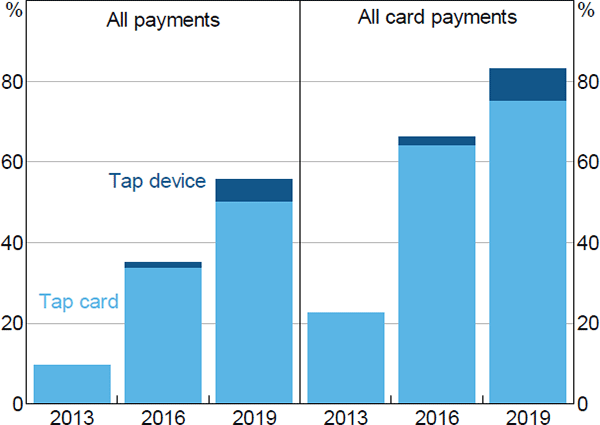RDP 2020-06: Consumer Payment Behaviour in Australia: Evidence from the 2019 Consumer Payments Survey Non-technical summary for ‘Consumer Payment Behaviour in Australia: Evidence from the 2019 Consumer Payments Survey’
September 2020
The payments landscape in Australia is rapidly changing. More and more Australian consumers are choosing to pay by card over cash and rising demand for fast, convenient and secure payments is leading to the adoption of new innovative payment methods. Understanding how consumers choose to pay is integral to considering ways to address and adapt to changes, particularly as new options emerge at a rapid pace.
Since 2007 the Reserve Bank has conducted a Consumer Payments Survey (CPS) every three years, which provides comprehensive information on how Australians make their payments. The 2019 CPS was conducted just before the emergence of COVID-19 in Australia and gives a detailed snapshot of consumer payment behaviour prior to the changes in spending patterns induced by the pandemic.
The survey provides further evidence that Australian consumers increasingly prefer to use electronic payment methods rather than cash for their day-to-day payments. Debit cards were the most frequently used consumer payment method in the 2019 CPS, and many people now prefer to ‘tap and go’ even for small payments.
| 2007 | 2010 | 2013 | 2016 | 2019 | |
|---|---|---|---|---|---|
| Cash | 69 | 62 | 47 | 37 | 27 |
| Cards | 26 | 31 | 43 | 52 | 63 |
| Debit cards | 15 | 22 | 24 | 30 | 44 |
| Credit and charge cards | 11 | 9 | 19 | 22 | 19 |
| BPAY | 2 | 3 | 3 | 2 | 2 |
| Internet/phone banking(a) | na | 2 | 2 | 1 | 3 |
| PayPal | na | 1 | 3 | 3 | 2 |
| Cheque | 1 | 1 | 0.4 | 0.2 | 0.2 |
| Other(b) | 1 | 1 | 2 | 4 | 2 |
|
Notes: Excludes payments over $9,999, transfers (payments to family and friends), transport cards and automatic payments Source: RBA calculations, based on data from Colmar Brunton, Ipsos and Roy Morgan Research |
|||||
Consumers are also increasingly taking advantage of the ability to make payments using a range of innovative new payment services that have emerged in recent years. These are often facilitated by mobile technology and the use of digital payment credentials. For example, the use of mobile devices for contactless ‘tap and go’ payments (which are included under card payments in the table) increased sharply since 2016 (see the graph below). Despite the trend towards electronic payments, cash still accounted for a significant share of lower-value payments and some people continue to make many of their payments in cash.
As the transition to electronic payments occurs, it will be important to make sure that electronic payment systems are low cost, accessible and safe. As the transactional use of cash declines, it will also be important to consider the needs of those members of society who continue to rely heavily on cash for their day-to-day payments.

Source: RBA calculations, based on data from Colmar Brunton, Ipsos and Roy Morgan Research
Selected results of the 2019 Consumer Payments Survey were also published in the March and June RBA Bulletin. The RDP contains a more comprehensive report on the survey results.
References
Caddy J, L Delaney, C Fisher and C Noone (2020), ‘Consumer Payment Behaviour in Australia’, RBA Bulletin, March, viewed 27 August 2020.
Delaney L, N McClure and R Finlay (2020), ‘Cash Use in Australia: Results from the 2019 Consumer Payments Survey’, RBA Bulletin, June, viewed 27 August 2020.